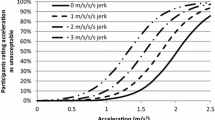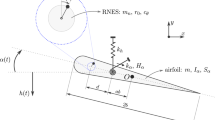Abstract
This paper deals with the lateral stability for a railway vehicle. Particularly, nonlinear critical speed is investigated via bifurcation analysis. Shooting method and trust region algorithm are applied to calculate the limit cycle of the nonlinear dynamic vehicle model. In case of the investigated vehicle model, the influences of the suspension parameters on the critical speeds are not large. The effects of friction coefficient are also small. However, there is an overall consistency that the nonlinear critical speed is decreased when the stiffness of the suspension is reduced. Study of the excitation conditions where the stable limit cycles occur gives very useful information to understand the nonlinear dynamic behavior of a railway vehicle and to test the vehicle with roller rig test stands. According to the results, the direction of the excitation is very important as well as the amplitude and frequency to acquire accurate nonlinear critical speed.
Similar content being viewed by others
References
S. Iwnicki, Handbook of railway vehicle dynamics, CRC Press, Boca Raton, USA (2006).
K. Knothe and F. Böhm, History of stability of railway and road vehicles, J. Vehicle System Dynamics, 31 (1999) 283–323.
H. True, On the theory of nonlinear dynamics and its applications in vehicle system dynamics, J. Vehicle System Dynamics, 31 (1999) 393–421.
G. Schupp, Bifurcation analysis of railway vehicles, Multibody System Dynamics, 15 (2006) 25–50.
C. Kaas-Pertersen, Chaos in a railway bogie, Acta Mechanica, 61 (1986) 89–107.
C. N. Jensen, M. Golubitsky and H. True, Symmetry, generic bifurcations, and mode interaction in nonlinear railway dynamics, Int’l. J. Bifurcation and Chaos, 9(7) (1999) 1321–1331.
K. Zboinski and M. Dusza, Self-exciting vibrations and Hopf’s bifurcation in non-linear stability analysis of rail vehicles in a curved track, European J. Mechanics A/Solids, 29 (2010) 190–203.
J. Zeng and P. Wu, Stability analysis of high speed railway vehicles, JSME Int’l Journal Series C, 47(2) (2004) 464–470.
H. True and R. Asmund, The dynamics of railway freight wagon wheelset with dry friction damping, J. Vehicle System Dynamics, 38(2) (2002) 149–163.
H. Molatefi, M. Hecht and M. H. Kadlvar, Effect of suspension system in the lateral stability of railway freight trucks, Proc. IMechE Part F: J. Rail and Rapid Transit, 221 (2007) 399–407.
O. Polach, Comparability of the non-linear and linearized stability assessment during railway vehicle design, J. Vehicle System Dynamics, 44 supplement (2006) 129–138.
O. Polach, On non-linear methods of bogie stability assessment using computer simulations, Proc. IMechE Part F: J. Rail and Rapid Transit, 220 (2006) 13–27.
A. A. Shabana, K. E. Zaazaa and H. Sugiyama, Railroad vehicle dynamics: A computational approach, CRC Press, New York, USA (2008).
J. J. Kalker, Three-dimensional elastic bodies in rolling contact, Kluwer Academic Publishers, Dordrecht, the Netherlands (1990).
O. Polach, A fast wheel/rail forces calculation computer code, J. Vehicle System Dynamics, 33 (1999) 728–739.
S. Lee and Y. Cheng, Nonlinear analysis on hunting stability for high-speed railway vehicle trucks on curved tracks, ASME J. Vibration and Acoustics, 127 (2005) 324–332.
V. K. Garg and R. V. Dukkipati, Dynamics of railway vehicle systems, Academic Press, Ontario, Canada (1984).
H. Hur, J. Park, W. You and T. Park, A study on the critical speed of worn wheel profile using a scale model, J. Mechanical Science and Technology, 23 (2009) 2790–2800.
J. Zeng, W. H. Zang, H. Y. Dai, X. J. Wu and Z. Y. Shen, Hunting instability and H∞ controlled stabilizer design for high speed railway passenger car, J. Vehicle System Dynamics, 28 supplement (1998) 655–668.
Y. Yuan, A review of trust region algorithms for optimization, Proceedings of ICIAM99, Edinburgh, UK (1999) 5–9.
N. K. Cooperrider, The hunting behavior of conventional railway trucks, ASME J. Eng. Industry, 94 (1972) 752–762.
J. T. Pearson, R. M. Goodall, T. X. Mei and G. Himmelstein, Active stability control strategies for a high speed bogie, Elsevier Control Engineering Practice, 12 (2004) 1381–1391.
S. Shen, T. X. Mei, R. M. Goodall, J. Pearson and G. Himmelstein, A study of active steering strategies for railway bogie, J. Vehicle System Dynamics, 41 supplement (2004) 282–291.
U. Wagner, Nonlinear dynamic behaviour of a railway wheelset, J. Vehicle System Dynamics, 47(5) (2009) 627–640.
Author information
Authors and Affiliations
Corresponding author
Additional information
This paper was recommended for publication in revised form by Editor Yeon June Kang
Joon-Hyuk Park received the B.S. degree from KAIST, Daejeon, Korea in 1998, and the M.S. and Ph.D. from Yonsei University, Seoul, Korea in 2000, 2005, respectively, all in Mechanical Engineering. He is a senior researcher at the Vehicle Dynamics & Propulsion Research Department in Korea Railroad Research Institute. His research interests are related to vehicle dynamics including the mechatronic railway vehicle and running test and evaluation technology for railway vehicles.
Hyo-In Koh received the M.A. degree in 2001 and the Dr. Ing degree in 2004 from Technical University of Berlin, Germany, in Technical Acoustics. She is a senior researcher at the Railway Environment Research Department in Korea Railroad Research Institute. Her research interests are related to noise reduction and acoustical environment in the railway system.
Nam-Po Kim received a B.S. in Mechanical Engineering from Ajou University in 1985. He then went on to receive his M.S. and Ph.D. degrees from Ajou University in 1992 and 2008, respectively. Dr. Kim is currently a principal researcher at the department of vehicle dynamics and propulsion system at Korea Rail Road Research Institute in Uiwang, Korea. His research interests are in the area of railway vehicle dynamics, active control of running gear for railway vehicle and vehicle system engineering.
Rights and permissions
About this article
Cite this article
Park, JH., Koh, HI. & Kim, NP. Parametric study of lateral stability for a railway vehicle. J Mech Sci Technol 25, 1657–1666 (2011). https://doi.org/10.1007/s12206-011-0421-0
Received:
Revised:
Accepted:
Published:
Issue Date:
DOI: https://doi.org/10.1007/s12206-011-0421-0




